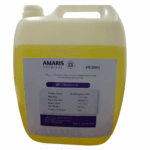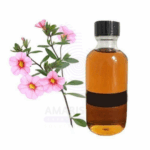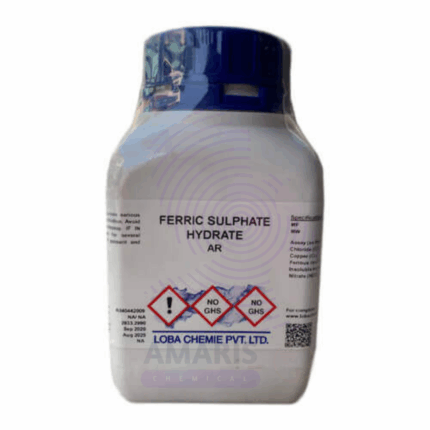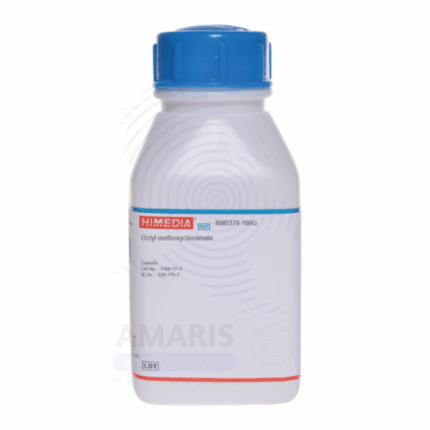Anhydrous Aluminum Chloride Extra Pure
- SHORT DESCRIPTION
Anhydrous Aluminum Chloride Extra Pure is a high-purity, white to pale yellow crystalline compound widely used in laboratory chemistry as a powerful Lewis acid catalyst. It plays a key role in organic synthesis, particularly in Friedel–Crafts alkylation and acylation reactions, and is essential in the study of electrophilic aromatic substitution mechanisms. Due to its extreme moisture sensitivity, it hydrolyzes rapidly upon exposure to air, releasing hydrogen chloride gas, and must be handled under strictly dry conditions. The extra pure grade ensures low levels of impurities, making it suitable for high-precision research and moisture-sensitive experimental work. It should be stored in airtight, moisture-free containers in a cool, dry environment, preferably under an inert atmosphere.
- USES
Primary Uses
- Lewis Acid Catalyst in Organic Reactions
- One of the most common Lewis acids used in Friedel–Crafts alkylation and acylation of aromatic compounds.
- Catalyst in Polymerization and Isomerization
- Employed in cationic polymerization of olefins and in rearrangement reactions, especially in petroleum and synthetic rubber chemistry (lab-scale).
- Precursor in the Synthesis of Other Aluminum Compounds
- Used to prepare organoaluminum compounds and aluminum alkoxides under anhydrous conditions.
- Study of Coordination Complexes
- Forms stable adducts with electron-donating ligands (ethers, halides), making it useful in ligand binding and complex formation research.
- Drying and Dehydrating Agent in Non-Aqueous Systems
- Serves as a powerful dehydrating agent in water-sensitive reactions, particularly in synthesis involving acid chlorides.
Secondary Uses
- Etching and Surface Treatment Research
- Used in metal surface modification, particularly in aluminum treatment and etching of semiconductors.
- Catalyst in Halogen Exchange Reactions
- Participates in halide abstraction or exchange processes, aiding in the synthesis of alkyl halides or halogenated aromatics.
- Study of Acid–Base Behavior in Non-Aqueous Media
- Ideal for demonstrating hard/soft acid–base theory, and exploring acid–base interactions in non-protic solvents.
- Investigation of Ionic Liquids and Molten Salt Systems
- Mixed with organic halides to form ionic liquids, studied for electrochemistry and green chemistry applications.
- Intermediate in Laboratory-Scale Aluminum Electrolysis or Vapor Deposition Studies
- Used to generate Al metal or AlCl₃ vapors for thin film deposition and electrochemical cell design.
KEY ATTRIBUTES
1. Basic Identification Attributes
- Chemical Name: Aluminum Chloride (Anhydrous)
- CAS Number: 7446-70-0
- HS Code: 28273000 (Aluminum chloride)
- Molecular Formula: AlCl₃
- Synonyms:
- Aluminum trichloride
- AlCl₃
- Trichloroaluminum
- Anhydrous aluminium chloride
2. Physical & Chemical Properties
- Physical State: Solid (powder or granules)
- Color & Odor: White to pale yellow; pungent, acidic odor due to hydrolysis
- Boiling Point: ~180 °C (sublimes)
- Melting Point: ~192.4 °C
- Density/Specific Gravity: ~2.44 g/cm³
- Solubility:
- Water: Reacts violently (hydrolyzes exothermically)
- Alcohol & Ether: Soluble
- pH Level: Strongly acidic upon contact with moisture
- Vapor Pressure: Moderate (sublimes easily at room temperature)
- Flash Point: Not flammable, but corrosive and reactive
- Autoignition Temperature: Not applicable
- Viscosity: Not applicable
3. Safety & Hazard Attributes
- Hazard Class (GHS):
- Corrosive to skin, eyes (Category 1)
- Serious eye damage (Category 1)
- Acute Toxicity – Inhalation (Category 3)
- Reacts violently with water
- NFPA Ratings:
- Health: 3
- Flammability: 0
- Reactivity: 2
- Exposure Limits:
- No specific OSHA/ACGIH limit for AlCl₃
- Use with proper ventilation and PPE
- Reactivity:
- Reacts exothermically with water or moist air
- Corrosive to most metals in presence of moisture
- Hydrolyzes to form HCl gas and aluminum hydroxide
4. Storage & Handling Attributes
- Storage Conditions:
- Store in a cool, dry, airtight container under inert atmosphere if possible
- Protect from moisture, air, and heat
- Incompatible Materials:
- Water, alcohols, bases, moist air, oxidizers
- Container Type:
- Sealed glass or PTFE-lined containers (non-reactive)
- Shelf Life & Expiration Date:
- ~1–2 years if properly sealed; degrades quickly with moisture
- Special Handling Requirements:
- Use in fume hood
- Gloves, goggles, and lab coat required
- Avoid inhalation of dust or fumes
5. Regulatory & Compliance Attributes
- Regulatory Status:
- Listed in TSCA, REACH
- Classified as corrosive and regulated under workplace safety regulations
- Transportation Restrictions:
- UN Number: UN 1726
- Hazard Class: 8 (Corrosive)
- Packing Group: II
- Waste Disposal Method:
- Neutralize cautiously before disposal
- Dispose as hazardous waste in compliance with local regulations
6. Environmental & Health Impact
- Ecotoxicity:
- Harmful to aquatic life due to acidity and aluminum ion release
- Persistence in Environment:
- Hydrolyzes rapidly in water to insoluble aluminum hydroxide
- Carcinogenicity/Mutagenicity:
- Not classified as carcinogenic
- Biodegradability:
- Inorganic; not biodegradable
SAFETY PRECAUTIONS
- Personal Protective Equipment (PPE):
- Wear chemical-resistant gloves (nitrile, neoprene), lab coat, and tight-fitting safety goggles.
- Use in a certified fume hood—AlCl₃ reacts violently with moisture, releasing hydrogen chloride (HCl) gas.
- Handling:
- Handle with extreme care—AlCl₃ is highly reactive and corrosive.
- Avoid any contact with water, moisture, or skin.
- Do not breathe dust or fumes.
- Use only non-metallic tools and containers where compatible.
- Storage:
- Store in airtight, sealed containers under dry, inert conditions (e.g., desiccator or glove box).
- Keep away from moisture, acids, bases, and oxidizers.
- Store in a cool, dry, well-ventilated area, away from flammable materials.
- Hygiene Measures:
- Wash hands and arms thoroughly after handling.
- Remove and clean contaminated clothing.
- Never touch face or eyes when handling AlCl₃.
FIRST AID MEASURES
- Inhalation:
- Move the person to fresh air immediately.
- If breathing is difficult, administer oxygen.
- Seek immediate medical attention—HCl vapors from hydrolysis can cause serious lung damage.
- Skin Contact:
- Brush off any dry particles, then wash skin with plenty of water for at least 15 minutes.
- Remove contaminated clothing.
- Seek medical attention for burns, irritation, or delayed symptoms.
- Eye Contact:
- Rinse eyes immediately with plenty of water for 15+ minutes.
- Hold eyelids apart and remove contact lenses if present.
- Seek emergency medical treatment—can cause severe eye damage or burns.
- Ingestion:
- Do NOT induce vomiting.
- Rinse mouth with water.
- Give water or milk only if the person is conscious.
- Seek immediate medical attention—may cause burns to the mouth, throat, and stomach.
FIRE FIGHTING MEASURES
- Suitable Extinguishing Media:
- Use dry powder (e.g., sand, Class D extinguisher), CO₂, or dry chemical.
- Do NOT use water or foam—reaction with water is violent and releases corrosive fumes.
- Specific Hazards:
- Reacts exothermically with water, releasing:
- Hydrogen chloride gas (HCl) – corrosive and toxic
- Aluminum hydroxide, forming a gelatinous mass
- Contact with organic materials may cause combustion.
- Reacts exothermically with water, releasing:
- Protective Equipment for Firefighters:
- Wear self-contained breathing apparatus (SCBA) and chemical-resistant gear.
- Firefighting Instructions:
- Evacuate area and fight fire from a safe distance.
- Cool unaffected containers with dry agents if possible.
- Avoid spreading spilled material—keep it dry and isolated.


 Preservatives(food)
Preservatives(food) Flavor Enhancers
Flavor Enhancers Acidulants
Acidulants Sweeteners
Sweeteners Antioxidants
Antioxidants Colorants(food)
Colorants(food) Nutraceutical Ingredients (food)
Nutraceutical Ingredients (food) Nutrient Supplements
Nutrient Supplements Emulsifiers
Emulsifiers
 Collectors
Collectors Dust Suppressants
Dust Suppressants Explosives and Blasting Agents
Explosives and Blasting Agents Flocculants and Coagulants
Flocculants and Coagulants Frothers
Frothers Leaching Agents
Leaching Agents pH Modifiers
pH Modifiers Precious Metal Extraction Agents
Precious Metal Extraction Agents
 Antioxidants(plastic)
Antioxidants(plastic) Colorants (Pigments, Dyes)
Colorants (Pigments, Dyes) Fillers and Reinforcements
Fillers and Reinforcements Flame Retardants
Flame Retardants Monomers
Monomers Plasticizers
Plasticizers Polymerization Initiators
Polymerization Initiators Stabilizers (UV, Heat)
Stabilizers (UV, Heat)
 Antifoaming Agents
Antifoaming Agents Chelating Agents
Chelating Agents Coagulants and Flocculants
Coagulants and Flocculants Corrosion Inhibitors
Corrosion Inhibitors Disinfectants and Biocides
Disinfectants and Biocides Oxidizing Agents
Oxidizing Agents pH Adjusters
pH Adjusters Scale Inhibitors( water)
Scale Inhibitors( water)
 Antioxidants(cosmetic)
Antioxidants(cosmetic) Emollients
Emollients Fragrances and Essential Oils
Fragrances and Essential Oils Humectants
Humectants Preservatives
Preservatives Surfactants(cosmetic)
Surfactants(cosmetic) Thickeners
Thickeners UV Filters
UV Filters
 Fertilizers
Fertilizers Soil Conditioners
Soil Conditioners Plant Growth Regulators
Plant Growth Regulators Animal Feed Additives
Animal Feed Additives Biostimulants
Biostimulants Pesticides (Herbicides, Insecticides, Fungicides)
Pesticides (Herbicides, Insecticides, Fungicides)
 Active Pharmaceutical Ingredients (APIs)
Active Pharmaceutical Ingredients (APIs) Excipients
Excipients Solvents(pharmaceutical)
Solvents(pharmaceutical) Antibiotics
Antibiotics Antiseptics and Disinfectants
Antiseptics and Disinfectants Vaccine Adjuvants
Vaccine Adjuvants Nutraceutical Ingredients (pharmaceutical)
Nutraceutical Ingredients (pharmaceutical) Analgesics & Antipyretics
Analgesics & Antipyretics
 Analytical Reagents
Analytical Reagents Solvents(lab)
Solvents(lab) Chromatography Chemicals
Chromatography Chemicals Spectroscopy Reagents
Spectroscopy Reagents microbiology-and-cell-culture-reagents
microbiology-and-cell-culture-reagents Molecular Biology Reagents
Molecular Biology Reagents Biochemical Reagents
Biochemical Reagents Inorganic and Organic Standards
Inorganic and Organic Standards Laboratory Safety Chemicals
Laboratory Safety Chemicals Specialty Laboratory Chemicals(Special Laboratory Equipment)
Specialty Laboratory Chemicals(Special Laboratory Equipment)
 Demulsifiers
Demulsifiers Hydraulic Fracturing Fluids
Hydraulic Fracturing Fluids Scale Inhibitors(oil)
Scale Inhibitors(oil) Surfactants(oil)
Surfactants(oil) Drilling Fluids
Drilling Fluids
 Dyes and Pigments
Dyes and Pigments Bleaching Agents
Bleaching Agents Softening Agents
Softening Agents Finishing Agents
Finishing Agents Antistatic Agents
Antistatic Agents
 Admixtures
Admixtures Waterproofing Agents
Waterproofing Agents Sealants and Adhesives
Sealants and Adhesives Curing Compounds
Curing Compounds Concrete Repair Chemicals
Concrete Repair Chemicals Anti-Corrosion Coatings
Anti-Corrosion Coatings
 Surfactants(cleaning)
Surfactants(cleaning) Builders
Builders Enzymes
Enzymes Solvents (Cleaning)
Solvents (Cleaning) Fragrances
Fragrances
 Electronic Chemicals
Electronic Chemicals Catalysts
Catalysts Lubricants
Lubricants Photographic Chemicals
Photographic Chemicals Refrigerants
Refrigerants Automotive chemicals
Automotive chemicals Pyrotechnic Chemicals
Pyrotechnic Chemicals
 Biodegradable Surfactants
Biodegradable Surfactants Bio-based Solvents
Bio-based Solvents Renewable Polymers
Renewable Polymers Carbon Capture Chemicals
Carbon Capture Chemicals Wastewater Treatment Chemicals
Wastewater Treatment Chemicals
 Pigments
Pigments Solvents(paint)
Solvents(paint) Specialty Coatings
Specialty Coatings Binders/Resins
Binders/Resins Additives
Additives Driers
Driers Anti-Corrosion Agents
Anti-Corrosion Agents Functional Coatings
Functional Coatings Application-Specific Coatings
Application-Specific Coatings
 Fresh Herbs
Fresh Herbs Ground Spices
Ground Spices Whole Spices
Whole Spices Spice Blends
Spice Blends Dried Herbs
Dried Herbs
 Leavening Agents
Leavening Agents Dough Conditioners
Dough Conditioners Flour Treatments
Flour Treatments Fat Replacers
Fat Replacers Decoratives
Decoratives Preservatives(baking)
Preservatives(baking)
 Plasticizers & Softeners
Plasticizers & Softeners Reinforcing Agents
Reinforcing Agents Adhesion Promoters
Adhesion Promoters Vulcanizing Agents
Vulcanizing Agents Antidegradants
Antidegradants Blowing Agents
Blowing Agents Fillers & Extenders
Fillers & Extenders Accelerators & Retarders
Accelerators & Retarders





















